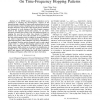Free Online Productivity Tools
i2Speak
i2Symbol
i2OCR
iTex2Img
iWeb2Print
iWeb2Shot
i2Type
iPdf2Split
iPdf2Merge
i2Bopomofo
i2Arabic
i2Style
i2Image
i2PDF
iLatex2Rtf
Sci2ools
ICC
2007
IEEE
2007
IEEE
Synchronization Signal Design for OFDM Based On Time-Frequency Hopping Patterns
— In an OFDM system, channel estimation can be considered as sampling the time-frequency response of the channel through a number of known pilot symbols placed across the time-frequency plane. Sampling theory dictates that the pilot insertion frequency must be above the Nyquist rates in both time and frequency to avoid aliasing of the delay-Doppler response. Based on the regularly spaced pilot pattern, we can derive alternative patterns that preserve the non-aliasing property by hopping the scan lines in either time domain or frequency domain, but not both. From this extended set of patterns, we find ones with properties that, in addition to channel estimation, can achieve responsively other synchronization tasks such as initial time-frequency offset estimation and device identification. The ambiguity function analysis frequently used in radar signal design leads to a periodic time-hopping pattern based on the Costas Array that has minimal coincidences with its circular time-freque...
Channel Estimation | Communications | ICC 2007 | Pilot Insertion Frequency | Time-frequency Offset Estimation |
| Added | 02 Jun 2010 |
| Updated | 02 Jun 2010 |
| Type | Conference |
| Year | 2007 |
| Where | ICC |
| Authors | Jiann-Ching Guey |
Comments (0)

